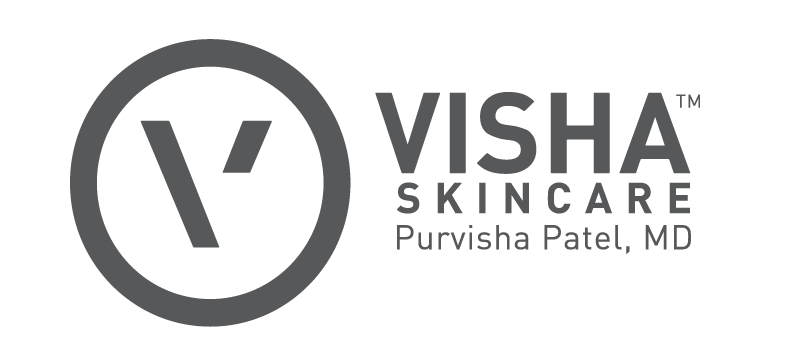
Byrdie posted “Are Pore Strips Bad for Your Skin? We Investigate” featuring Dr. Purvisha Patel and Visha Skincare. The article includes Dr. Patel’s expert commentary on pore strips, including whether they work as well as effective skin care products, including the Advanced Purifying Cleanser.
Remember when pore strips first surfaced? Happy teens graced television ads, peeling away a paper-like strip from their noses and marveling with delight at all the gunk that came out. For me, I’ve never truly experienced the happy-teen-in-a-pore-strip-commercial sensation: Usually, when I peel them away, my eyes water, I pause in between small tears to take a breather, re-evaluate my life decisions, and curse the skin gods for burdening me with clogged pores, all to finally unveil just a few clogs leftover on the strip. A quick (and gross) Google search will have you believe that pore strips are extremely effective, so maybe I’ve just always done it wrong? However, a poll in the office made us all question whether these painful strips are even safe in the first place.
While pores strips possibly can be effective at removing buildup inside the pores, the effects are not long-lasting, and the strips can cause more harm than good to the skin. I reached out to dermatologists Dendy Engelman, MD, Jennifer Herrmann, MD, Nava Greenfield, MD, and Purvisha Patel, MD, for their honest, no-holds-barred take on using them. Take a look at what they had to say below.
How Do Pore Strips Work?
In theory, pore strips work to clean your pores by clinging to the buildup inside them. “Pore strips are strips of material with an adhesive on one side to adhere to and pull out open comedones or blackheads,” Patel explains. “Blackheads happen when oil in the pores of the skin is exposed to air and oxidized, resulting in [a black appearance]. If the adhesive truly grabs the oil and pulls it out, voilá—the blackhead is taken out.”
MEET THE EXPERT
Purvisha Patel is a board-certified dermatologist and cosmetic surgeon and creator of Visha Skincare.
As far as their effectiveness, other dermatologists aren’t so convinced. Patel continues, “The ability of the strip to adhere and clear the pores is a variable factor, and pore strips may not work for everyone, especially those that may have adhesive allergies.” Herrmann adds, “Although they are marketed well, most aren’t powerful enough to ‘clean’ pores.”
MEET THE EXPERT
Jennifer Herrmann is a board-certified dermatologist and dermatologic surgeon at MFC Dermatology in Beverly Hills.
Greenfield doesn’t seem to think they’re any more effective as a longterm solution, either. “I am not a fan of pore strips,” Greenfield says. “They occasionally do a fair job at removing keratin buildup in pores, but the pores will fill right up again. The underlying issues, which are enlarged pores and overactive sweat glands, are not addressed with the strips.”
MEET THE EXPERT
Nava Greenfield is a dermatologist who practices at Schweiger Dermatology Group in NYC.
Are Pore Strips Safe?
If you like the peeling sensation and instant gratification of a pore strip too much to kick the habit, despite what you now know about its effectiveness (or rather, ineffectiveness), you might be wondering if it’s safe to do anyway. The conclusion: Peel at your own risk.
“If they contain alcohol or other astringents, they can be irritating to sensitive skin,” Herrmann says. Engelman cites another important piece of info to know about your pores: They don’t open and close, so clearing them out won’t make them physically “smaller”—in fact, by yanking away at a pore strip, you could be enlarging them. She explains, “I’m always wary of pore strips because while they [may] be fun, you risk damaging the skin and thus, make your pores bigger.”
MEET THE EXPERT
Dendy Engelman is a board-certified dermatologic surgeon at Medical Dermatology & Cosmetic Surgery in NY.
What to Use to Clean Your Pores Instead
While pore strips may “work” for you, the dangers outweigh the benefits. As a result, we asked for a few effective methods to help remove the gunk in your skin.
Visha Advanced Skincare Purifying Cleanser $30
“Cleansing with a strong oil-busting wash that also exfoliates, such as Visha Skincare Advanced Purifying Cleanser, is a more surefire way of eliminating blackheads,” says Patel. This formula contains a combination of chemical exfoliators salicylic acid (BHA) to exfoliate deep inside the pores and glycolic acid (AHA) to slough away the dead cells on the skin’s surface.
Skinceuticals Retinol 1.0 Maximum Strength Refining Night Cream $76
Several of the dermatologists also recommend using retinoids to help sweep out pore-clogging debris. Says Greenfield, “I would recommend using something that addresses the underlying concern. For example, a retinoid cream can improve the appearance of the pores and also decrease sweat gland product.” Because retinoids are known to be irritating, this formula also contains bisabolol and Boswellia serrata extract to soothe skin and counteract the drying effects of the 1% retinol in this night cream.
Differin Gel $12
Herrmann adds, “Using a retinoid or retinol can help reduce blockage more effectively and prevent acne.” This over-the-counter retinoid cream is a dermatologist favorite for its effectiveness in reducing and preventing acne.
If you have a bit more to spend, try getting an in-office treatment. Herrmann recommends an Oxygeneo Facial, which oxygenates the skin from within, or a laser treatment like Clear + Brilliant, which she says will reduce the look of pores temporarily.
The Final Takeaway
While pore strips are a fun and satisfying way to unclog your pores, the dermatologists we consulted are not convinced they’re worth the possible damage they can cause to the skin. Stick with other, safer–albeit slightly less exciting–methods when deep cleaning your pores for better results.

